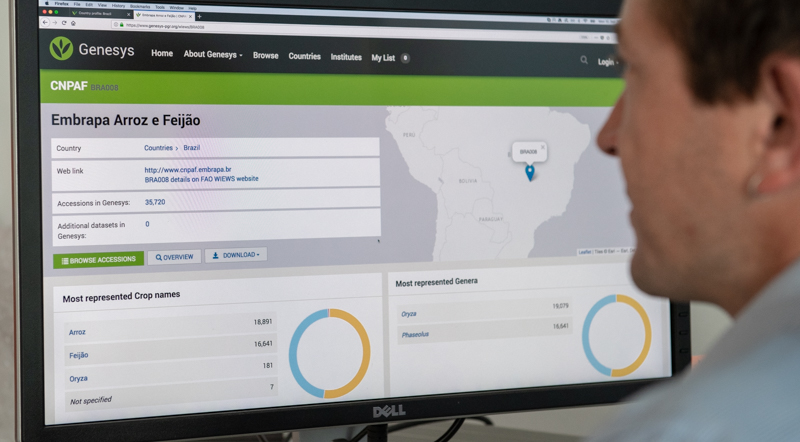Category : Feature Stories
Published : September 18, 2018 - 11:01 AM

Brazil conserves an enormous wealth of crop diversity and is using this diversity to transform its production systems and become a global agricultural powerhouse. This critical resource is maintained in 140 germplasm different collections in 35 decentralized units of the Brazilian Agricultural Research Corporation (EMBRAPA). As a result of a collaboration with the Crop Trust, EMBRAPA is now making vital information on these collections publicly available on the Internet, for the benefit of all in our interdependent world.
Each sample conserved in these collections has a story to tell, a story which has been documented by the guardians and users of this crop diversity. The data contains basic passport information, like the locality where the samples were collected, their taxonomic identification, and field observations about what the material looks like and how it was being cultivated. This data will be critical in developing fully informed conservation strategies, and in guiding use. Each of the 140 EMBRAPA collections has some sort of database on the tens of thousands of crop samples they contain, but many of them are no more than simple spreadsheets.
From spreadsheets to Alelo
“We wanted to make sure this wealth of data is available to the world. But before we could go global we had to improve our information systems at the local level. So, we developed the Alelo portal to standardize data from the different collections and make the data available from a central portal,” said Gilberto Hiragi, an information technology analyst at EMBRAPA who’s been responsible for Alelo. “The main goal of Alelo is to be the central platform for managing our active germplasm banks.”
Alelo staff have taken on the mammoth task of visiting Brazil’s germplasm collections and have provided training to local staff on database management and guidelines on how to structure their data. As a result of the visits, the passport data of 75,000 accessions has been added to Alelo. This compilation and migration of data has led to increased efficiencies in genebanks, such as identifying duplicates in collections and identifying missing accessions through gap analysis
“After we built up the Alelo portal, the next step was to publish the data to Genesys,” said Gilberto. Genesys is the global portal for plant genetic resources and allows users to simultaneously search for accessions across multiple collections in various countries. Genesys helps plant breeders, and other users of plant genetic resources, to track down the materials that they need to request and eventually use in their crop improvement efforts and research. For genebank managers across the world, it allows them to better understand what materials are conserved where, and that helps them focus their limited resources on what’s really needed. For example, Genesys can tell you what material is in the International Treaty on Plant Genetic Resources for Food and Agriculture’s Multilateral System, and is duplicated in the Svalbard Global Seed Vault.
Committed to the Seed Treaty
“Brazil ratified the Seed Treaty in 2006 and this shows our commitment to sharing our data with the global community,” said Gilberto. “Adding our data to Genesys is a huge step toward achieving this sharing objective. This is the main reason why we are conserving this diversity in the first place … so we can share with the global community.” Genesys is recognized a central pillar of the Treaty’s Global Information System (GLIS).
However, sharing the Brazilian data on Genesys required more than a click of a button. “We worked closely with the Alelo project team to help implement the protocols that allow for automated data publication on Genesys,” said Matija Obreza, the Crop Trust’s Information Systems Manager. The hard work of developing the Alelo-to-Genesys integration paid off. Database specialists at EMBRAPA have implemented the tools for uploading the accession data from Alelo using the Genesys API. In late April, EMBRAPA added 192,356 accessions to Genesys.
“This amount of data is an enormous contribution to Genesys and GLIS,” said Matija. “Brazil is now the fifth biggest provider to Genesys after the CGIAR genebanks, EURISCO, USDA, and Australia,” said Matija.
“This activity is an important part of the Crop Wild Relatives Project’s efforts to strengthen genebank information systems around the world and to make sure genetic material, including CWR, is available, and used,” said Hannes Dempewolf, Head of Global Initiatives at the Crop Trust. “In Latin America alone, aside from the work carried out with EMBRAPA, the CWR Project has carried out several assessments of information systems of national genebanks. It has also provided funding to strengthen infrastructure and equipment in countries such as Peru, Ecuador, Bolivia and Guatemala.”
The addition of the Brazilian data to Genesys and GLIS is a tremendous boon to researchers, breeders and ever farmers who want to explore some of the largest and most diverse collections of crop diversity in the world.
###
This information systems project is part of ‘Adapting Agriculture to Climate Change: Collecting, Protecting and Preparing Crop Wild Relatives’ project, funded by the Norwegian Government, and coordinated by the Crop Trust with the Millennium Seed Bank, Kew. All materials produced by the project will be made available to users through the standard material transfer agreement (SMTA).
